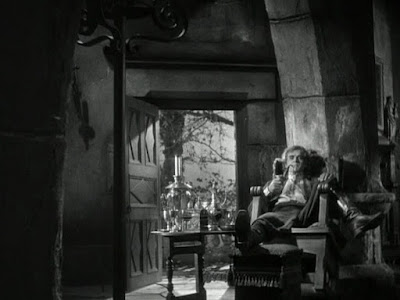Movies that showcase one actor playing identical twins, with one twin evil and the other kind, tend to be silly and gimmicky at best and offensive at worst, but this Gothic horror period piece, with Boris Karloff as twin brothers Gregor and Anton, is pretty elegant and effective, with Karloff finding different mannerisms, personality traits, affectations, and slight changes in speech to flesh out and differentiate both parts. Director Roy William Neill presents it all mostly seriously, with just the right flavoring of camp, and the production benefits from having the full financial weight of Paramount Pictures behind it, sparing little expense on lavish sets and crowds of extras.
The Black Room begins in a castle in a small Tyrolean village in the late 18th century. The Baron's wife has just given birth, but the color drains from the Baron's face (or so I assume; it's a B&W movie) when he learns she has delivered twin boys. The Baron doesn't have anything personal against twins, but the prophecy that has so far foretold an accurate history of his bloodline is pretty clear that the family line will end with twin brothers, with the younger (by one minute) killing the older in the castle's Black Room. This is exactly how the dynasty began, with brother Ram killing his slightly older twin brother and first baron Wolfram.
The Baron is extremely bummed about the prophecy, even though most of his peers no longer believe in it, but he bounces back when one of them suggests walling up the Black Room. Problem solved, right? In a quick montage, we learn of the eventual deaths of the Baroness and Baron, and we flash forward 20 years after the twins' teen years to find Gregor the ruling baron at the castle and Anton living the quiet life in a nearby village with his beloved mastiff Tor (played by Von the Dog, who would go on to star in four more films and a documentary about movie dogs). Anton has been away for a decade, but Gregor invites him for a visit, with dark ulterior motives.
Anton arrives at the village pub, discovering how hated his brother is by the townspeople, and, riding in his brother's coach to the castle, he barely misses a bullet meant for Gregor. Back at the castle, Anton sees that Gregor has become a creepy, paranoid tyrant, but he doesn't realize things are even worse than that. Gregor is a predator and murderer of women, with several women in the village disappearing shortly after being in or near the castle.
The townspeople, long suspecting Gregor, have had enough, and an angry mob is forming to give Gregor what he deserves. Meanwhile, Gregor has a creepy fixation on a young woman named Thea (Marian Marsh), the niece of the village's colonel, Paul (Thurston Hall), and he is determined to make her his bride despite her complete aversion to him and her own engagement to a young lieutenant. The timing of all this turmoil and Anton's visit are not coincidental, and Gregor has a dark plot in the works.
You probably see where this is going, and several moments in the film's conclusion are telegraphed pretty far in advance, but the story is presented with such style, skill, flair, and graceful camera movement that it's never less than satisfying. There are a few awkward, gimmicky trick shots of Karloff talking to Karloff, but these are dispensed with relatively early in the running time. The beautiful and beautifully Gothic village, castle, and graveyard sets are given their full due on camera, and Neill and his cinematographer Allen G. Siegler frame and photograph some spectacular shots and images. The actors do a great job of matching the film's mostly serious/slightly camp tone. Karloff is particularly great, but the rest of the cast does fine work, too, even the initially dull young lovers.
Another important character, castle servant Mashka, is played by Katherine DeMille, who has a pretty wild Hollywood story of her own. She was born in Canada to a Scottish father and an Italian/Swiss mother, though she lost both parents at a young age. Her father was killed in WWI, and her terminally ill with tuberculosis mother took young Katherine to California to find the child's grandparents, who had emigrated there. Katherine's mother died before finding them, and the child was placed in a Los Angeles orphanage run by the wife of famous director/producer Cecil B. DeMille, Constance Adams. Adams and DeMille were unable to conceive again after their first child, so they adopted Katherine when she was 11. Katherine became a movie star and had a long but sometimes unhappy marriage to Anthony Quinn. She quit the movie business in grief after the couple's oldest son drowned in a pond at W.C. Fields' home at the age of two or three, but she returned for a handful of roles nearly a decade later. The perennially unfaithful Quinn left her in the 1960s for his mistress, and she spent her final years out of the limelight with family in Arizona.
Director Neill was born on a ship off the coast of Ireland, which his father was captaining. Jeez, these people's lives are something else. He directed a staggering number of movies at a prolific pace from the silent era through the mid-1940s, dying of a heart attack in '46. Though most of these were low-budget b-movies (The Black Room was one of his rare big-budget productions), some critics and historians credit his visual style as one of the inspirations for film noir. Neill is most famous for directing the bulk of the Basil Rathbone-starring Sherlock Holmes movies, but he also made several horror films (and several films in almost every genre, for that matter; he directed 111 movies in all; no wonder the guy had a heart attack).











No comments:
Post a Comment